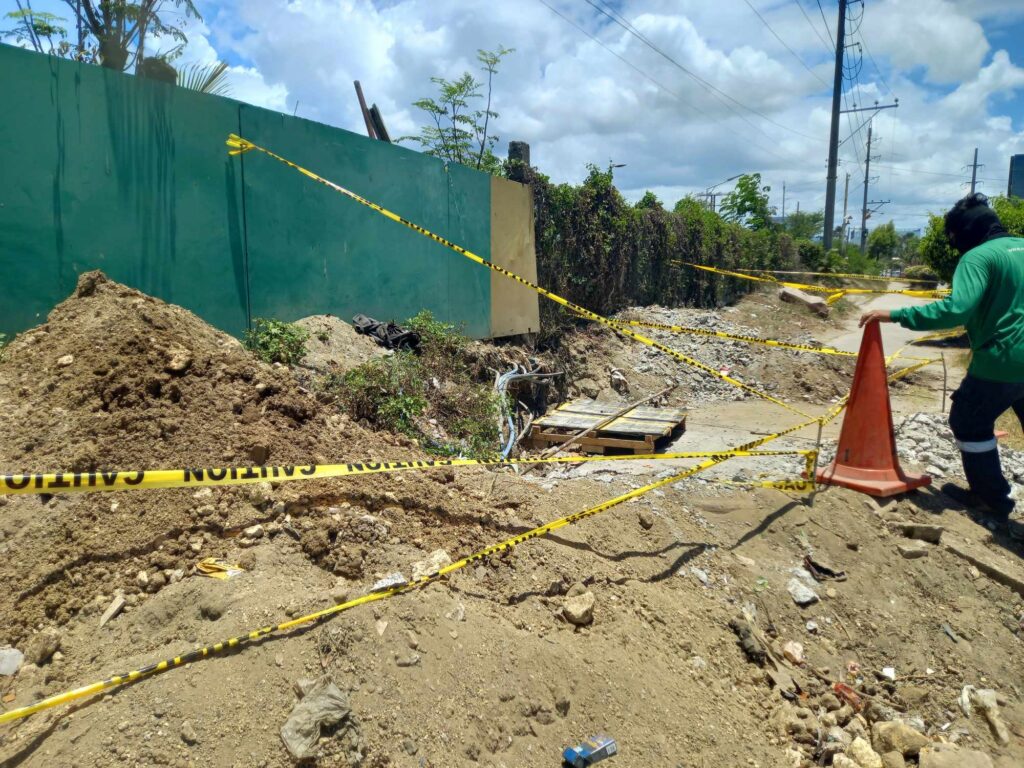
Personnel from NGCP checked the underground cable, the 138 kilovolts line that was accidentally hit by the contractor personnel of the Visayan Electric Company on Monday afternoon.
CEBU CITY, Philippines — Seeing spaghetti and dangling wires are not so uncommon, especially in the Philippines. Sometimes, when you take a photo, it tends to ruin the view or the aesthetics.
But with the innovation paired with the brilliance of the experts and engineers, there is a solution for it—placing the wires underground which is notably known as the underground cabling or the underground electrical distribution system.
According to Visayan Electric Co. (VECO), that had already started this project not so long ago, that underground electrical distribution systems “offer a range of benefits, particularly in terms of aesthetics, safety, and reliability.”
However, the electric company said that these advantages come with trade-offs in terms of higher initial costs, maintenance challenges, and potential environmental impact during installation.
VECO added that careful consideration of these factors would be essential when deciding whether to implement an underground system, balancing the immediate costs against the long-term benefits and needs of the community.
“This is why highly-developed countries have governments subsidizing the cost of an underground distribution system,” the electric company told CDN.
Cebu City is planning to start this project this year, and the removal operations for the spaghetti or unnecessary wires were already in place, according to Councilor Jerry Guardo, the City Council’s chairman for the Committee on Infrastructure and chairman of the Technical Infrastructure Committee.
Will this be beneficial to the community? What will be the challenges if this underground distribution system (UDS) is fully implemented in the city?
Here are some advantages and disadvantages of the underground electric distribution system, as provided by VECO.
Advantages
1. Aesthetic Benefits
Improved visual appeal: Underground systems eliminate the need for poles and overhead wires, resulting in a cleaner, more aesthetically pleasing environment, especially in urban and suburban areas.
Example: Fuente Osmena Circle to Capitol and Fuente Osmena Circle to Corner P. Del Rosario.
2. Reduced Vulnerability to Weather
Protection from storms: UDS are less susceptible to damage from wind, rain, and other severe weather conditions, leading to fewer outages. During the recent Typhoon Odette, no UDS equipment or network was impaired.
Decreased maintenance: Fewer weather-related repairs and outages result in reduced maintenance costs over time.
3. Enhanced Safety
Lower risk of electrical hazards: Eliminating overhead lines reduces the risk of electrical hazards to people and animals, such as accidental contact or electrocution.
Fire prevention: Underground cables are less likely to cause fires, which can be a significant risk with overhead lines, especially in dry, high-vegetation areas.
4. Space Optimization
Urban planning: More space is available for other utilities and urban development since underground systems do not require poles and wide right-of-ways.
5. Improved Reliability
Fewer to no outages: UDS tend to have fewer interruptions compared to overhead systems, as they are protected from many of the external factors that cause outages such as kites, vegetation, objects, animals, lightning, and many others.
6. Environmental Benefits
Reduced impact on wildlife: Underground systems are less disruptive to wildlife and do not pose a risk to birds and other animals that might come into contact with overhead lines.
Disadvantages
1. Higher Initial Costs
Installation expense: The cost of installing underground systems is significantly higher than overhead systems due to the need for excavation, specialized equipment, and labor.
Complex installation: Complexities in routing cables, especially in dense urban areas with existing infrastructure (i.e. water, telco), can add to the cost and complexity of installation.
Need for redundancy: Due to lead time constraints of specialized equipment and the possible downtime when a failure occurs, a redundancy system is required. This requirement increases the Capital requirement for an underground system.
2. Difficulties in Maintenance and Repair
Access issues: Locating and accessing underground faults can be challenging and time-consuming, often requiring excavation and sophisticated diagnostic tools.
Repair costs: Repairing underground cables can be more expensive and labor-intensive compared to overhead lines, due to the need for digging and potentially complex work environments.
3. Environmental and Land Use Concerns
Disturbance during installation: The process of burying cables can be disruptive to the environment and existing landscapes, requiring significant land disturbance. Acquisition of the necessary permits from all regulators is a must.
Water table and soil conditions: Installation and long-term performance can be affected by soil conditions and water tables, potentially leading to additional engineering challenges and costs.
4. Operational Challenges
Heat dissipation: Underground cables have more difficulty dissipating heat compared to overhead lines, which can limit their capacity and efficiency. These cables are derated. Hence, a bigger size cable is often required. This increases the Capital requirement.
Flooding and water ingress: Systems in flood-prone areas can be at risk of water ingress, which can cause outages and damage to the infrastructure. Hence, for flood-prone areas, water blocking and/or seals are required.
5. Limitations in Upgrading
Future expansion: Upgrading or expanding underground systems can be more complex and costly, as it may require significant excavation and reengineering.
There may be a couple disadvantages of having UDS, but looking ahead, its advantages far outweigh the disadvantages especially when you are seeking for development and improvement in the long run.